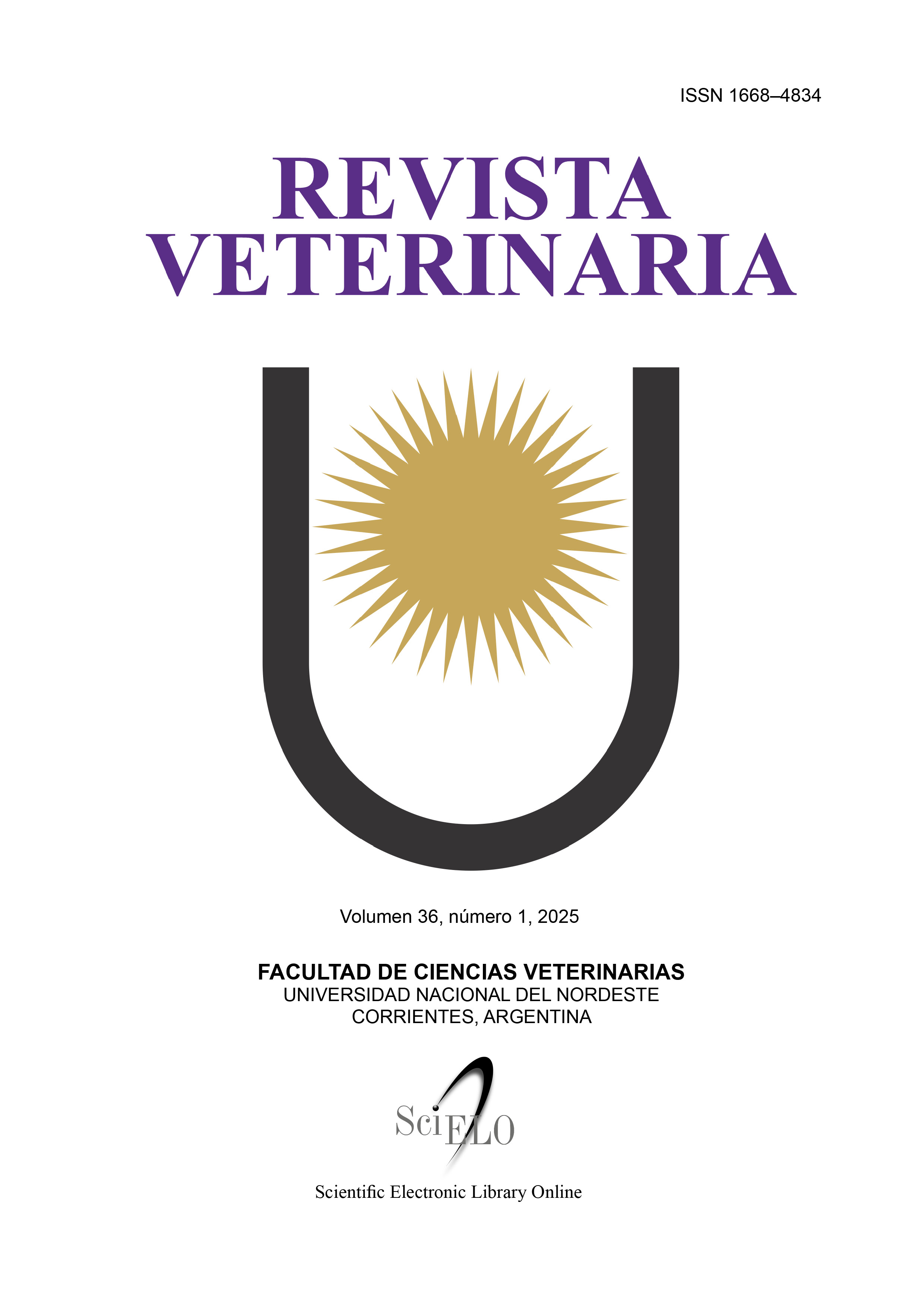Genotoxicidad de pesticidas: el papel de los ingredientes no activos
DOI:
https://doi.org/10.30972/vet.3618111Palabras clave:
Amitraz, viabilidad celular, genotoxicidad, ensayo cometa cuantitativo, ensayo de micronúcleos, cultivo celularResumen
Amitraz es un insecticida y acaricida a base de formamidina de uso veterinario. A pesar de que se han utilizado diversos criterios de valoración genéticos y sistemas de prueba para la investigación sobre el envenenamiento por amitraz, los resultados que surgieron de estas investigaciones fueron diversos y no concluyentes. El objetivo de este estudio fue analizar el potencial genotóxico del insecticida amitraz y comparar el efecto del componente activo y un producto comercial que contiene amitraz. Se cultivaron células de ovario de hámster chino durante un ciclo celular en medio Ham F12 con concentraciones de 1,25; 2,5 y 3,75 μg ml-1 de amitraz. Se emplearon los ensayos de micronúcleos con bloqueo de la citocinesis y cometa cuantitativo para evaluar el posible efecto genotóxico. Todos los parámetros de genotoxicidad evaluados mostraron claramente la capacidad de la formulación comercial de amitraz para afectar negativamente al ADN, induciendo daño tanto citogenético como citomolecular. Después de cultivar las células con el componente activo de la fórmula, solo se encontró un ligero aumento no significativo del daño. Como nuestros hallazgos demostraron que el componente activo de la fórmula no es el único responsable del efecto genotóxico del producto comercial, enfatizamos la importancia de tener en cuenta el efecto adverso de los solventes utilizados en las formulaciones comerciales de pesticidas.
Descargas
Citas
Avsarogullari L, Ikizceli I, Sungur M, Sozuer E, Akdur O, Yucei M. Acute amitraz poisoning in adults: clinical features, laboratory findings, and management. Clin. Toxicol. 2006; 44: 19-24.
Bolognesi C. Genotoxicity of pesticides: a review of human biomonitoring studies. Mutat. Res. 2003; 543: 251-272.
Caprotta CG, Martinez M, Tiszler M, Guerra V. Amitraz poisoning. Arch. argent. Pediatr. 2009; 107: 449-458.
Carranza-Martin AC, Fabra MC, Urrutia Luna N, Farnetano N, Anchordoquy JP, Anchordoquy JM, Picco SJ, Furnus CC, Nikoloff N. In vitro adverse effects of amitraz on semen quality: Consequences in bovine embryo development. Theriogenology. 2023; 199:106-113.
del Pino J, Moyano-Cires PV, Anadon MJ, Díaz MJ, Lobo M, Capo MA, Frejo MT. Molecular mechanisms of amitraz mammalian toxicity: a comprehensive review of existing data. Chem Res Toxicol. 2015; 28(6):1073-1094.
Dhooria S, Agarwal R. Amitraz, an underrecognized poison: A systematic review. Indian J Med Res. 2016; 144: 348-358.
Fenech M, Chang WP, Kirsch-Volders M, Holland N, Bonassi S, Zeiger E. HUuman MicronNucleus project. HUMN project: detailed description of the scoring criteria for the cytokinesis-block micronucleus assay using isolated human lymphocyte cultures. Mutat. Res. 2003; 534: 65-75.
Fenech M. Cytokinesis-block micronucleus cytome assay. Nat. Protoc. 2007; 2: 1084-1104.
Fereydooni S, Arfaee F, Youssefi M, Zahra F, Gharib F, Tabari M. In vitro toxicity of combination of amitraz and carvacrol on Demodex canis. Open Vet. J. 2023; 13: 894-902.
Giorgini M, Taroncher M, Tolosa J, Ruiz MJ, Rodríguez-Carrasco Y. Amitraz and its metabolites: oxidative stress-mediated cytotoxicity in hepG2 cells and study of their stability and characterization in honey. Antioxidants. 2023; 12(4): 885.
Ghosh S, Ojha PK, Carnesecchi E, Lombardo A, Roy K, Benfenati E. Exploring QSAR modeling of toxicity of chemicals on earthworm. Ecotoxicol Environ Saf. 2020; 190: 110067.
Hu S, Benner C, White J, Martin R, Feenstra K. Pharmacokinetics and brain distribution of amitraz and its metabolites in rats. Environ Toxicol Pharmacol. 2019; 65: 40-45.
Khan SJ, Roser DJ, Davies CM, Peters GM, Stuetz RM, Tucker RNJ. Ashbolt chemical contaminants in feedlot wastes: concentrations, effects and attenuation. Environ. Int. 2008; 34: 839-859.
Kim K, Kabir E, Jahan S. Exposure to pesticides and the associated human health effects. Sci Total Environ. 2017; 575: 525-535.
Końca K, Lankoff A, Banasik A, Lisowska H, Kuszewski T, Góźdź S, Koza Z, Wojcik A. A cross-platform public domain PC image-analysis program for the comet assay. Mut. Res. 2003; 534: 15-20.
Marafon CM, Delfim CI, Valada CA, Menotti R, Andrade SF. Analysis of amitraz in cats by gas chromatography. J. Vet. Pharmacol. Ther. 2009; 33: 411-414.
Mnif W, Hassine A, Bouaziz A, Bartegi A, Thomas O, Roig B. Effect of endocrine disruptor pesticides: A review. Int J Environ Res Public Health. 2011; 8(6): 2265-2303.
Moro AM, Brucker N, Charão M, Bulcão R, Freitas F, Baierle M, Nascimento S, Valentini J, Cassini C, Salvador M, Linden R, Thiesen F, Buffon A, Moresco R, Garcia SC. Evaluation of genotoxicity and oxidative damage in painters exposed to low levels of toluene. Mut. Res. 2012; 746: 42-48.
Nanjundappa S, Narayanan S, Darsana Udayan N, Kanapadinchareveetil S, Jacob M, Ravindran R, Juliet S. Disposition Kinetics of Amitraz in Lactating Does. Molecules. 2021; 26: 4769-4772.
Nikoloff N, Carranza Martin A, Fabra C, Furnus C. Amitraz induced cytotoxic effect on bovine cumulus cells and impaired oocyte maturation. Environ Sci Pollut Res. 2021; 28: 29188-29199.
Olive P. DNA damage and repair in individual cells: applications of the comet assay in radiobiology. Int J Radiat Biol. 1999; 75: 395-405.
Osano O, Oladimeji AA, Kraak MH, Admiraal W. Teratogenic effects of amitraz, 2,4-dimethylaniline, and paraquat on developing frog (Xenopus) embryos. Arch Environ Contam Toxicol. 2002; 43: 42-49.
Padula G, Ponzinibbio MV, Picco S, Seoane A. Assessment of the adverse effects of the acaricide amitraz: in vitro evaluation of genotoxicity. Toxicol. Mech. Methods. 2012; 22: 657-666.
Proudfoot AT. Poisoning with amitraz. Toxicol. Rev. 2003; 22: 71-74.
Prueitt RL, Rhomberg LR, Goodman JE. Hypothesis-based weight-of-evidence evaluation of the human carcinogenicity of toluene diisocyanate. Crit. Rev. Toxicol. 2013; 43: 391-435.
Radakovic M, Stevanovic J, Djelic N, Lakic N, Knezevic-Vukcevic J, Vukovic-Gacic B, Stanimirovic Z. Evaluation of the DNA damaging effects of amitraz on human lymphocytes in the Comet assay. J. Biosci. 2013; 38: 53-62.
Roberts J, Reigart R. Recognition and Management of Pesticide Poisoning, US EPA Office of Pesticide Programs, 2013; Sixth Edition.
Rojas-García A, Solís-Heredia M, Paredes S, Pérez-Maldonado I. Occupational exposure to pesticides and DNA damage in workers from the state of Nayarit, Mexico. Environ Sci Pollut Res. 2011; 18: 987-996.
Singh NP, Mc Coy M, Tice R, Schneider E. A simple technique for quantization of low levels of DNA damage in individual cells. Exp. Cell Res. 1988; 175: 184-191.
Strober W. Trypan blue exclusion test of cell viability. Curr Protoc Immunol. 2015; 111: A3.B.1-A3.B.3.
Tice R, Strauss G. The single cell gel electrophoresis/comet assay: a potential tool for detecting radiation-induced DNA damage in humans. Stem Cells. 1995; 13: 207-214.
Tice RR, Agurell E, Anderson D, Burlinson B, Hartmann A, Kobayashi H, Miyamae Y, Rojas E, Ryu J, Sasaki Y. Single cell gel/comet assay: guidelines for in vitro and in vivo genetic toxicology testing. Environ. Mol. Mutagen. 2000; 35: 206-221.
USEPA (United States Environmental Protection Agency). Amitraz Reregistration Eligibility Decision (RED), Case 0234. (EPA-738-F-96-031), US Environmental Protection Agency, Office of Prevention, Pesticide and Toxic Substances, Washington, DC. 1996.
Ulukaya S, Demirag K, Moral AR. Acute amitraz intoxication in human. Intensive Care Med. 2001; 27: 930-933.
Wang F, Li C, Liu W, Jin Y. Oxidative damage and genotoxic effect in mice caused by sub-chronic exposure to low-dose volatile organic compounds. Inhal. Toxicol. 2013; 25: 235-242.
Westermann CM, Boerma S, van Nieuwstadt RA. Amitraz intoxications in the horse: cases and backgrounds. Tijdschr Diergeneeskd. 2004; 129: 438-441.
Young FM, Phungtamdet W, Sanderson BJS. Modifi cation of MTT assay conditions to examine the cytotoxic effects of amitraz on the human lymphoblastoid cell line, WIL2NS. Toxicol. in Vitro. 2005; 9: 1051-1059.
Descargas
Publicado
Versiones
- 2025-03-06 (2)
- 2025-03-06 (1)
Cómo citar
Número
Sección
Licencia

Esta obra está bajo una licencia internacional Creative Commons Atribución-NoComercial 4.0.
Política de acceso abierto
Esta revista proporciona un acceso abierto inmediato a su contenido, basado en el principio de que ofrecer al público un acceso libre a las investigaciones ayuda a un mayor intercambio global de conocimiento. La publicación por parte de terceros será autorizada por Revista Veterinaria toda vez que se la reconozca debidamente y en forma explícita como lugar de publicación del original.
Esta obra está bajo una licencia de Creative Commons Reconocimiento-NoComercial 4.0 Internacional (CC BY-NC 4.0)










.jpg)
.jpg)



